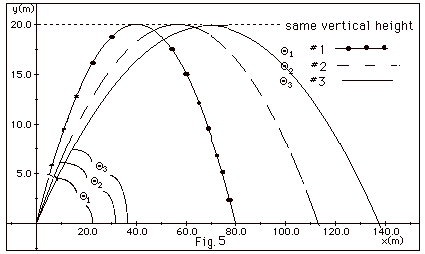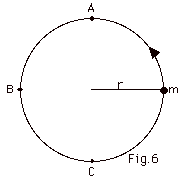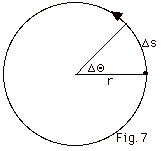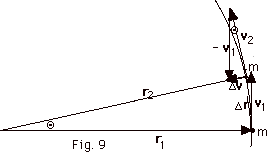|
Review - Two Dimensional Motion
|
|
|
1.
|
An object experiences displacements s1
and s2, as shown in Fig. 1a below. Is the
resultant displacement s shown in Fig. 1b or Fig. 1c?
Explain your answer.

|
|
|
2.
|
Show how two displacement vectors, one
of magnitude 6 m and the other of magnitude 8 m, can be combined
to give a resultant of (a) 2 m, (b) 14 m, and (c) 10 m.
|
|
|
3.
|
Vector A has magnitude 10 cm and
makes an angle of 37o with the x-axis. Vector B
has components Bx = 8 cm and By = -2
cm.
Sketch the vector C = A + 1/2 B and determine
its components, its magnitude, and the angle it makes with
the x-axis.
|
|
|
4.
|
A particle moves 7.00 m along the positive
Y-axis and then 7.07 m at angle of 45o with the
X-axis, as shown in Fig. 2 below. Find the resultant displacement
r = r1 + r2 of
the particle. Express r in terms of (a) unit vectors
i and j and (b) its magnitude and direction.

|
|
|
5.
|
A pitcher throws a baseball with a horizontal
velocity of 132 ft/s (90 mph) toward home plate that is approximately
60 ft away. What is the vertical drop of the ball when it
reaches the plate? g = 32 ft/s2.
|
|
|
6.
|
A young man practicing his pitching
stands on a cliff and tosses a rock at a velocity of 24 m/s
in a horizontal direction. At this instant a person in a car
at rest in a service station 90 m from the cliff "guns"
the car at a constant acceleration of 4.0 m/s2
toward the cliff. The rock hits the car. (a) How long is the
rock in the air? (b) How high is the cliff?
|
|
|
7.
|
A ball rolls off the edge of a 1.0 m-high
table with a speed of 4.0 m/s. How far horizontally from the
edge of the table does the ball strike the floor?
|
|
|
8.
|
When an object is given an initial velocity
vox along a horizontal frictionless surface, it travels
a distance x = voxt in time t.
When an object is given an initial velocity vertically upward
of voy from an initial height yo, it rises
until its velocity vy = 0.
The maximum height ymax it rises can be found from
0 = vy2 = voy2
+ 2ay(ymax - yo),
where ay = -9.8 m/s2 ≈ -10 m/s2.
The time t it is in the air is found when
y = 0 = yo + voyt + 1/2
ayt2.
The velocity at this time t is given by vy(t) =
voy + ayt.
The principle of superposition states that when a body is subjected
to two or more separate influences it responds to each without
altering its response to the other.
If the object is given an initial velocity of vo
at angle Θ such that the
components of its velocity are the same vox and voy
as given above, what happens to the quantities t, ymax,
vy(t), and x? |
|
|
9.
|
Find and draw the horizontal and vertical
components of the projectile's velocity in Fig. 3 below (a)
at the initial position i, (b) at the highest point h, and
(c) just before it hits the ground at f. (d) Draw the velocity
vector at h and f. (e) Draw the acceleration vectors for x
= 20.0, 30.0 and 40.0 m.

|
|
|
10.
|
An object is shot into the air with an
initial velocity vo = 25 m/s at an angle of 37o
above the horizontal at a height of 20 m above the earth's
surface (Fig. 4 below). Take g = 10 m/s2. Find
and draw the horizontal and vertical components of the projectile’s
velocity in Fig. 4 (a) at the initial position, (b) at the
highest point. Find (c) the maximum height ymax
to which the object rises, (d) the time for it to return to
the earth, (e) the distance moved horizontally, and (f) draw
the horizontal and vertical components of the velocity just
before it hits the ground. (g) Draw the velocity vector just
before it hits the ground and find its magnitude and direction.

|
|
|
11.
|
For the projectile of Fig. 4 above, write
numerical expressions for:
(a) the initial position vector ro = xoi
+ yoj,
(b) the initial velocity vector vo = voxi
+ voyj,
(c) the acceleration vector a = -ayj,
(d) the velocity at any time t vector v(t) = vxi
+ vyj,
and
show that:
(e) v(t) = vo + at,
(f) the position vector as a function of time r(t)
= xi + yj, and
(g) r(t) = ro + vot
+ 1/2 at2.
|
|
|
12.
|
A boy throws a ball into the air as hard
as he can and then runs as fast as he can under the ball in
order to catch it. If his maximum speed in throwing the ball
is 20 m/s and his best time for a 20-m dash is 3.0 s, how
high does the ball rise? Take g = 10 m/s2.
|
|
|
13.
|
A driven golf ball just clears the top
of a tree that is 15 m high and is 30 m from the tee, and
then lands (with no roll or bounce) on the green, 180 m from
the tee. What was the initial velocity imparted to the golf
ball? Take g = 10 m/s2.
|
|
|
14.
|
Projectiles in Fig. 5 below are shot
off at different angles with Θ1
(path designated –•–•–•–•–) greater
than Θ2 (path
designated with __ __) greater than Θ3
(path designated _____ ), but the maximum vertical
height reached by each projectile is the same. (a) If t1
represents the time for the object to reach the ground when
projected at angle Θ1,
t2 the time to reach the ground when launched at
angle Θ2, and
t3 for the one at angle Θ3,
find whether (i) t1 > t2 > t3, (ii)
t3 > t2 > t1, or (iii)
t1 = t2 = t3. (b) The initial
velocity for path #1 is (i) greater than the initial velocity
for path #2 which is greater than the initial velocity for
path #3, (ii) less than the initial velocity for path #2 which
is less than the initial velocity for path #3, (iii) is the
same as the initial velocity for path #2 and path #3. (c)
Are your answers to (a) and (b) consistent with the fact that
the range for path #3 is the greatest? Explain your answers.

|
|
|
15.
|
A small object of mass m rotates counterclockwise
on a horizontal frictionless plane at the end of a string
of length r = 0.4 m with constant speed v = 2.0 m/s. On Fig.
6 below draw the magnitude and direction of (a) the velocity
and (b) the centripetal acceleration at points A, B, and C.
(c) Are the velocity and the acceleration constant? (d) Could
you use this method to find how an object would withstand
a number of "g's"? Explain your answers.

|
|
|
16.
|
(a) The period T of an object moving
with uniform circular motion is defined as the time for one
complete rotation. Find the period for the particle in #15.
(b) The frequency f of an object is defined as the number
of rotations it makes per second. Find the frequency of the
particle in #15. How is the frequency related to the period?
Write an expression for the centripetal acceleration in terms
of (c) π, r, and T, (d)
π, r, and f.
|
|
|
17.
|
An angle in radians is defined as the
arc an angle subtends divided by the radius of the circle.
(a) In Fig. 7 below, what does the angle ΔΘ equal?
(b) The magnitude of the angular velocity of the particle
ω is defined as the limit
of ΔΘ/ Δt
as Δt approaches zero.
Find ω. (c) The direction
of ωis found by
curling the fingers of your right hand in the direction of
motion. Your thumb then points in the direction of the motion.
What is the direction of ω?
(d) Is uniform circular motion a case of constant angular
velocity?

|
|
|
18.
|
In time t, an object moving with constant
angular velocity ωrotates
through angle Θ= ωt.
Find (a) r(t) in unit vector notation, (b) v(t)
in unit vector notation, (c) vx, vy
and v, (d) a(t) in unit vector notation, (e) ax,
ay, and a. (f) Draw the vectors v and a
and their components on Fig. 8 below.

|
|
|
19.
|
Figure 9 below represents an object
moving in a circle with uniform circular motion. In this type
of motion, the magnitude of the velocity v remains
constant, but its direction is always tangent to the path.
The direction continuously changes. Uniform circular motion
is an example of constant speed, but not of constant velocity.
That is v1 = v2, but v1
is not equal to v2. The object of
mass m is located on the circle initially by the position
vector r1 with its instantaneous velocity
v1 tangent to the circle or perpendicular
to r1. Later the velocity v2
is perpendicular to the position vector r2.
The displacement vector Δr
= r2 – r1. In Fig.
9, the negative of the position vector r1
has been added to r2 to give r2
– r1 = Δr.
(a) Use the triangle with r2, r1,
Δr and the triangle
with v2, v1, Δv
to find an expression for Δr/r
and Δv/v. Recall that
r2 = r1 and v2 = v1.
Now find an expression for the acceleration from a = lim Δt
 0 of
Δv/ Δt. 0 of
Δv/ Δt.
(b) Find the direction of the acceleration from a =
lim Δt  0
of Dv/ Δt. 0
of Dv/ Δt.

|
|